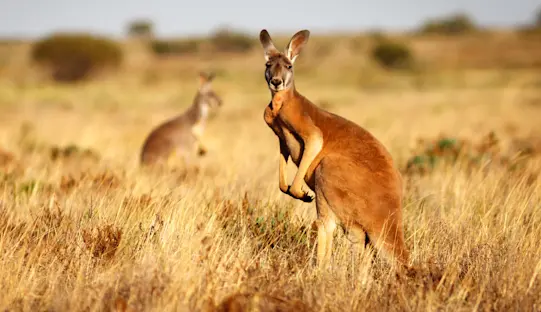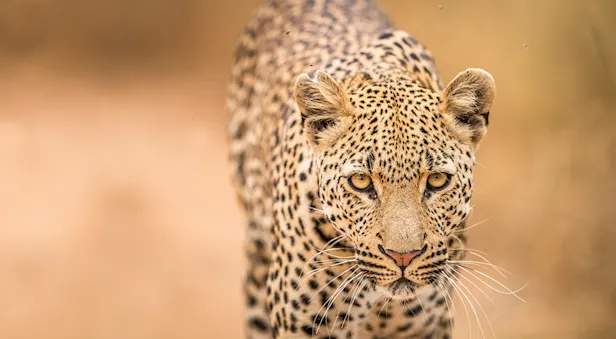
Know Before You Go


African Elephant Facts | Southern Africa Wildlife Guide
Physical Characteristics
Largest surviving land animal
Dextrous trunk containing around 100,000 muscles
Wide, arching ears that radiate heat to cool the body
Head that is disproportionately large compared to its body
Height of 8.2 to 13 feet at the shoulder, and weight of 2.5 to 7 tons
Toenails rather than hooves
Pair of breasts between the forelegs
Testicles of males lie inside the body cavity close to the kidneys
Back molars grind food, such as bark and branches from trees and bushes
Ivory tusks are almost worth their weight in gold
Live up to 70 years in the wild
Habitat
Elephants once roamed freely throughout Africa; now, they occupy only one-fifth of the continent. Although elephants currently number between 700,000 and 1 million, their range and numbers are rapidly dwindling. Over the past 20 years, illegal poaching, primarily for ivory, has reduced most East African populations by nearly 90 percent. Despite international concern for their threatened status, some conservative figures suggest that elephants will be virtually eliminated in East Africa within the next 20 years. However, they have been comparatively protected in Southern Africa and fortunately can be seen in large numbers in Botswana, Zimbabwe, South Africa and Namibia.
Elephants occupy all African habitats from near-desert to closed canopy forest. The inherent mobility of these animals allows them to select food from a variety of habitats over an extensive home range, which may be thousands of square miles in area. For a large part of the year, the availability of grass is important; the presence of perennial water within their range is essential. Elephants move both daily and seasonally between different parts of their habitat, from woodland to grassland, and from bushland to swamp and back again.
Elephants are active during both night and day. This is due to the fact that they have a 16- to 20-hour waking period, which must necessarily spill into the dark hours, the bulk of which is spent feeding. A midday siesta in the shade is common. In addition, if the group feels secure, they will indulge in a period of deep sleep at night, even lying down.
Behavior
Elephants are as sociable creatures as primates; greeting elephants will either put their trunks in each other’s mouths or touch and smell each other’s temporal glands. Such welcoming gestures probably reveal subtle states of mood, as well as identity. Like many other African herbivores, elephants may urinate or defecate to mark territory and for recognition. When two family units reunite after several days or weeks of separation, there is much squealing and trumpeting, pirouetting, backing up, greeting and excreting.
At least once a day, elephants will bathe, wallow or dust, primarily for cooling purposes and to rid themselves of parasites. Trunks full of liquid or dust are blown between the legs, on top of the head, or along the flanks. The habit of frequent mud bathing and dusting leaves elephants more the color of local soil than the natural gray of their skins. Adopted colors range from light gray to red to dark brown, allowing the observer to guess from which location a group of elephants has recently come.
The only serious threat to an adult elephant are human beings, who will eventually either displace all wild elephant populations as they spread into marginal lands, or kill them directly for their ivory. However, an unarmed human has little chance at close range against an angry elephant. The frequently observed headshake, often accompanied by an audible ear snap, is a strong warning to stay away. A serious charge, on the other hand, is strangely quiet; the elephant runs at nearly 22 miles-per-hour, ears out, head lowered, trunk curled under.
Elephant Society
The basic social group within the elephant herd is the family unit, comprising several related adult females and their immature offspring. This unit is led by the eldest cow—the matriarch. The herd bull does not exist, except in the preconceptions of observers. Adult males tag along with family units for short periods of time in order to inspect females for their readiness to mate. These visiting bulls play no leadership roles within the group, although they will assist in defense if necessary.
Bulls drift from family unit to family unit, and from time to time, into loosely knit bull groups—two to 20 males who move together for a day, a week or a season. A bull group’s composition changes continually; larger bulls, newly ousted from their family unit, can quickly find teachers, companionship and safety within the groups.
A family unit can contain up to 15 members. Beyond this size, the group is likely to split in half, each new group going its own way; one is led by the old matriarch, the other by one of her sisters or cousins. Family units may show strong associations with certain other units in a particular area. Such associations are a likely result of blood relations between the matriarchs, who were probably sisters or cousins in a previous unit.
With the onset of the rains and abundant grass growth, however, family groups are likely to join together in larger groups, which in the past have numbered more than 1,000 members. Bull groups will satellite around such assemblages, with many bulls entering the group to test the females. The frequency of mating is high, and this seasonal gathering of the clans may help to facilitate breeding in a species that is usually very wide-ranging and extremely mobile.
Older elephants provide the family unit with an important historical memory of watering holes, the location of seasonally available fruits, as well as other dispersed features of their world. Even a menopausal cow can retain her role as matriarch, suggesting that wisdom, and not just sex appeal, is a predominant quality for an elephant decision-maker.
Recent research has shown that elephants are highly vocal animals. Low frequency sounds, well below or at the very edge of human perception, allow contact to be maintained for up to six miles. The deep rumble heard from time to time is a contact vocalization, (“Here I am. Where are you?”) which just barely enters the range of human perception. Low frequency sound is an efficient form of transmission, especially where there is interference from vegetation. Elephants also roar and scream audibly through the trunk to produce classical trumpeting, either in anger or exultation, depending on the situation.
Breeding
If not pregnant or lactating, females may come into season every two or three months. This fact, in addition to the generally wide dispersal of an elephant population, makes it necessary for males to move among family units, constantly testing for female readiness to mate. An interested male will walk past a female, surreptitiously sniff her vulva and then put the tip of his trunk into his mouth to confirm the test.
It was once thought that only Asian elephant males came into sexual season, a period of ill temper called musth. Recent studies show that African elephant males also show seasonal fluctuations in their temper and sexual motivation and display conspicuous physiological indicators. The annual two- to three-month period of irascibility is accompanied by the penis taking on a characteristic greenish hue and strong smell. The odor is detectable to human observers, so it must be nearly overwhelming to other elephants.
The signs of musth, usually attributed only to irritable males, are now known to be inherent in both sexes. A liquid oozes from the temporal gland, a modified tear duct halfway between the ear and the eye, leaving a conspicuous dark stain along the side of the face. This secretion, called temporin, accompanies states of excitement, such as when there is a frightening disturbance or if close relatives reunite after a period of separation. A bull in musth is more likely to displace his peers when it comes to winning the favors of a female.
Occasionally, a female in estrus and a large courting bull, usually in musth, will consort for a time; they stay close together, pay attention to one another and exclude others from any intimacy. Consorting may be very subtle, or actually take the pair some distance away from the family unit and other bulls; this may account for the old tale of elephant “marriages.” Consorting may not always be so tender, however, and often the male may first have to “catch” the female. If the consorting female breaks into a run, the male will take off after her. A female can actually outrun a male if she wishes; getting caught is probably her way of choosing the bull that she prefers.
The female will usually stop once the male touches her, particularly if he is able to lay his trunk along her back or across her shoulders. He then rests his head and tusks on her rump and heaves himself up on his hind legs. Copulation lasts less than a minute. Strangely, the rest of the family unit is either indifferent to the copulation, or reacts with great excitement—vocalizing, ear flapping, head shaking, turning, backing and excreting.
The Young
Elephant calves spend several years dependent upon and learning from the adults, during which time there is nearly constant contact between mother and young. Young calves will suckle for a period of up to five years, reaching from the side for its mother’s teat just behind her front leg. Bulls tend to stay with their family units until they reach puberty; females, on the other hand, may stay with the group for life. Juveniles in a relaxed, undisturbed and healthy population are a pleasure to watch playing with each other—chasing, mounting, play fighting and even engaging in tug-o-wars. An elephant’s long period of childhood is matched only by that of higher primates, including humans.
Defense Mechanisms
Group defense is a common practice among elephants. When threatened, if simply moving away from the source is not effective, another tactic is employed. The next line of defense is to draw up a formidable wall of adult females to face the intrusion, with heads high, ears out, looking to and fro as if trying to make out the exact source of the annoyance. For security, the young members of the group are pushed towards the rear. In full retreat, however, the group runs off in a tight bunch, with the young protected in the middle.
The Sick
A wounded or sick elephant causes great concern within the group. Faltering animals will be kept upright between two or more adults. Fallen animals will be fussed over with trunks and feet; tusk-breaking attempts to lift a downed elephant have often been observed. The strange habit of burying a dead or immobilized animal is also well documented. Trunks full of dirt are tossed over the animal; branches are broken off and laid tenderly over the body, until it is completely covered. Human victims of elephant attacks have been treated in a similar manner, the reason for which is unknown.
Feeding Habits
Elephants feed up to 16 hours a day, using their trunks to reach food sources from ground level to nearly 16 feet high. Feeding techniques are varied; nearly all vegetative material is eaten, from staples such as grass, to trees, seeds, herbs and creepers. Even tree bark is stripped off acacia trees in certain seasons. While feeding on grass, elephants sometimes detect the occasional herb or creeper by smell and pluck them out. In this way, odd individuals break the feeding pattern as they come across an interesting “side dish” or a new bulk food. The entire group may then shift to the new delicacy. Elephants are also attracted to over-ripe fruit trees and have been known to gorge themselves to the point of intoxication on fermenting fruit.
An elephant’s trunk is its principal feeding tool. Its main function is to reach downward to harvest grass, the bulk of the elephant’s diet. The trunk, an astonishingly mobile and dextrous collection of muscles, evolved from a combining of nose and upper lip. It has a “two-fingered” tip, used for smelling, picking and plucking.
Tusks are also important tools and are actually modified front biting teeth, not canines, as might be expected. They are used for chiseling, digging, prizing, levering and stabbing. Elephant ivory grows four inches per year, so the frequently broken tips are continually replaced by new growth. This fact has inspired suggestions of “live harvesting” of ivory in order to save elephant lives, which is a complicated and costly technique, but feasible. Less than 2 percent of elephants are naturally tuskless.
The remaining elephant teeth, the molars, are also unique. In its lifetime, an elephant has only six teeth on each side of each jaw, 24 in all. The teeth are large, eight to 12 inches long, so only one or two halves, end to end, are exposed on each jaw side at a time. Molars grow progressively forward, which provides scientists with a means of telling an elephant’s age. Chewing is done forward and backward; the lower jaw grinds against the upper in the forward stroke. Since elephants spend most of the day eating, they are almost continuously chewing.
An adult elephant can eat up to 300 pounds of vegetation a day. Water is also essential—123 to 158 liters per day—both for cooling and helping with digestion. Water is sucked into the trunk and then tipped and released into the mouth. Animals less than six months old have not yet learned this trick, so instead, they drink from their knees, sucking water directly into their mouths. At wells or at a normal watering hole, elephants easily displace all other animals, including buffaloes and rhinos, and have been known to kill if it comes to a fight.

































